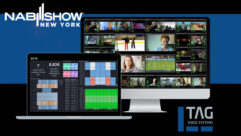Technology Showcase: Multi-Effects Processors
Dec 1, 2003 12:00 PM,
By Tom Dambly
The category of multi-effects processors opens the door to a dizzying array of audio gear and a wide range of sonic applications. With many products in their third or fourth generation, multi-effects boxes have outgrown mere utility status — overall sound quality is better than ever, with 24-bit resolution and high sampling rates quickly becoming the norm. As technology continues to advance, features and algorithms are finding their way from companies’ high-end dedicated processors to more moderately priced lines of multi-effects units.
Current offerings cover the gamut of effect types, the most prevalent being time-based processes such as reverb, delay, and echo or modulation effects such as chorusing, flanging, and phasing. These are often combined with dynamics processors, equalizers, or filters. Then the features become more diverse: pitch shifting, vocoding, amplifier modeling, and rotary speaker simulation are just a few of the effects you can find.
Whether you are building a sound system for a club, a house of worship, or an auditorium; choosing a processor for a mobile effects rack; or upgrading your studio, budget and space constraints will probably prevent you from specifying multiple racks of single-function audio processors. It’s also likely that your gear will need to serve multiple purposes, so flexibility is key. Either way, the world of multi-effects units is worth exploring.
This showcase surveys 1U rackmount digital units with at least 20-bit resolution and that offer more than one category of audio processing. The vast majority include reverb and feature at least one other principal application, as well as an MSRP of less than $2,500. Products that are vocal processors, guitar effects, or mastering units are not included. All of the processors covered here are suitable for use as in-line premix effects or with a mixer in an effects send/return arrangement.
THE PROCESSORS
Behringer’s 2-channel Virtualizer Pro DSP2024P features a total of 71 effect algorithms, including reverb, delay, chorus, flange, phase, pitch shift, EQ, and dynamics, as well as a range of modulation and distortion effects. Several of the reverb presets use Behringer’s virtual room algorithms, and several special effects from the company’s Modulizer Pro processor (such as a ring modulator and a voice canceler) are included.
Each effect has as many as seven adjustable parameters, which are controlled from the unit’s front-panel buttons and jog wheel. One hundred factory and a like number of user-definable presets are available. The unit’s dual-engine design allows processing in mono or stereo modes, with some presets using multiple effects arranged in series or in parallel.
The Virtualizer’s analog inputs and outputs use 24-bit converters, operating at the unusual sampling rate of 46.875 kHz. The unit is flexible with respect to I/O; it accepts balanced or unbalanced inputs and has ¼-inch and XLR connectors for both input and output. A switch on the back panel allows you to switch between +4 dBu and -10 dBV operation. MIDI implementation includes remote changing of presets with Program Change messages and storage of presets with system-exclusive data.
The Alesis Akira is a 2-channel effects processor that includes reverb, delay, flange, phase, chorus, filter, pitch, and distortion effects. Its roster of guitar-type modulation effects makes it especially useful for music applications. The unit has 50 factory programs that can be selected and modified directly from the front-panel controls; as many as 50 user-defined presets are possible. Each effect has three adjustable parameters that are mapped to the three knobs on the front panel, where an LED display shows program numbers or parameter values.
Akira analog inputs and outputs use 24-bit converters and a sampling rate of 48 kHz. Among the filter choices are EQ effects such as lowpass, bandpass, and highpass EQs; the miscellaneous effects include a tape saturation simulator, an optical limiter simulator, and a subharmonic synthesizer for reinforcement of low frequencies. The Akira uses MIDI continuous controller and Program Change messages for remote control of effect parameters and presets.
The 2-channel TC Electronic M300 dual digital signal-processing design combines a dedicated reverb processor with a multi-effects processor that can produce delay, tremolo, chorus, phase, or flange effects or act as a compressor or de-esser. Analog I/O uses 24-bit converters at 44.1/48 kHz, and 24-bit digital I/O is built in.
A hardware switch on the back panel sets the M300 to route signals through the two processors in series so one effect can be added to another or individually so they can be used as separate effects in an aux send/return arrangement. The 256 factory presets cover the possible combinations of 16 multi-effects and 16 reverb algorithms; for any variations on those, there can also be as many as 99 user-defined presets.
The M300 front panel is simple to navigate, with dedicated knobs and switches for input and output, multi-effect, and reverb settings and presets. For reverb and delay effects with tempo-based material, a Tap Tempo key and timing controls are available, and the unit can also synchronize to MIDI Clock input. The M300 also accepts MIDI continuous controller and Program Change messages to change effect parameters and presets.
Like the M300, the M One XL from TC Electronic has a 2-channel, dual-engine architecture that delivers two simultaneous effects but with more processing options and greater signal-routing flexibility. Available effects include reverb, delay, tremolo, chorus, phase, flange, expander, gate, compressor, limiter, and de-esser. You can select from any of the 25 effects on either processor, so two instances of the same effect (for example, two reverbs) can be run simultaneously. Each processor can also be bypassed separately.
The M One XL’s versatility comes from the six signal-routing options for the two effects processors: dual mono, serial, parallel, parallel/serial mix, dual send/return, and stereo linked. You can lock the routing setup so that the I/O configuration stays the same across all presets, maintaining the connections in your effects chain.
Also like the M300, analog I/O uses 24-bit converters at 44.1/48 kHz, and digital I/O is 24-bit; in addition, the digital output can be dithered to 20-bit or 16-bit resolution, allowing direct connection to a wider range of digital devices. The “XL” indicates balanced inputs and outputs.
An LCD shows input levels, signal-routing mode, and the current effect at a glance. Full MIDI control of presets and effect parameters is available, and tempo-based effects can be controlled with the Tap Tempo switch on the front panel or MIDI Clock input.
The DigiTech Studio Quad 4 processor, the only processor with more than two independent channels covered in this survey, offers reverb, compression, gate, chorus, flange, tremolo, pitch, EQ, and a range of modulation effects. The four inputs and outputs use 20-bit converters operating at a 44.1 kHz sampling rate. The Quad 4 can apply as many as four effects simultaneously in 16 routing configurations, including a setup that provides four separate, simultaneous effects. Modifier modules include an low-frequency oscillator (LFO), an envelope follower, and MIDI continuous controller input.
The Quad 4 provides for flexible arrangement of effects and modifiers, with programs classified according to their complexity and channel configuration (mono, dual, or true stereo). One hundred factory and 100 user-configurable presets are available. Remote program and parameter changes are possible through MIDI input.
Lexicon’s MPX-550 is a 2-channel processor that combines reverb processing with a compressor stage, making it useful for studio or live sound design applications. The MPX-550 has 24-bit converters on its balanced analog inputs and outputs and 24-bit digital inputs and outputs.
The MPX-550’s 255 factory presets include a constellation of classic Lexicon reverb and ambience algorithms, as well as tremolo, chorus, flange, and pitch effects. Presets include single or dual programs, with dual-channel operation permitting the combination of two effects in dual stereo (parallel), cascade, mono split, or dual mono modes. As many as 64 user-programmable presets are available.
The dedicated stereo compressor, which occurs in the signal path before any other effects, can be used to modify the dynamic contour of the material to be processed. Full and independent control over ratio, threshold, attack, and release settings is available.
When working with tempo-based material, the timing of the MPX-550 delay and modulation effects can be controlled by any of three methods: with a Tap Tempo function, by providing rhythmic audio input (in live applications), or by synchronizing to MIDI Clock. Presets and parameter changes can be performed with MIDI Program Change and continuous controller data.
The MPX-1 is Lexicon’s dual-engine version of the 2-channel MPX processor, which can apply as many as six independent effects simultaneously in any signal-routing configuration. Its flexible front-panel controls and program-editing capabilities make the MPX-1 convenient for live applications.
The MPX-1 list of effects covers the range of reverb and ambience, delay, tremolo, chorus, flange, and pitch effects and adds a parametric EQ. (The MPX-1 does not include the compression stage included in the MPX-550.) As with the other MPX-series processors, 24-bit conversion is used for analog I/O, and 24-bit digital I/O is standard.
The MPX-1’s program library, which has 200 factory and 50 user-programmable presets, is stored as a database that can be sorted by criteria such as program name, number, source type, and effect type, allowing for quick location of presets. Standard MIDI control features allow for preset changes and modulation of effect parameters, and built-in patching capability permits mapping of parameters to front-panel controls or to a MIDI controller.
An onboard A/B glide function can be invoked to smooth the transition between program or parameter changes. Tempo control options include synchronizing to Tap Tempo or to MIDI Clock, as well as the capability to transmit MIDI Clock to other tempo-sensitive devices. In addition, the MPX-1 has several internal controllers, including two low-frequency oscillators, two envelope generators, a random generator, a MIDI arpeggiator, the A/B glide function, two envelope followers, and a sample-and-hold controller.
The most recent release in Yamaha’s SPX line of high-end multi-effects processors, the 2-channel SPX2000 adds 96 kHz sampling-rate support and the company’s new REV-X reverb algorithms to the SPX processor feature list. Analog and digital inputs and outputs operate at 24-bit resolution. Additional connections include Word Clock input for synchronization with external digital devices, MIDI for standard MIDI I/O and remote control, and a USB connector for computer-based control.
The SPX2000 hosts new and classic Yamaha effects, including reverb, delay, pitch, chorus, flange, phase, tremolo, multiband dynamics, distortion, and loop sample functions, which can be applied to a variety of studio and live situations. Two effects can be composited by mixing their parallel processes or by adding their processes serially. Single and composite effects are accessible from 122 factory and 99 user-definable presets.
Program editing and selection are possible from the front-panel buttons and LCD. Effects that have a tempo parameter can be set from the front-panel controls or synchronized using the Tap Tempo button or MIDI Clock input. MIDI system control options include Program and parameter changes, note on/off messages, and data dump commands. In addition, Yamaha Studio Manager software can be used for program editing, data management, and remote control from a computer.
Eventide’s Eclipse is a dual-engine, 2-channel processor loaded with a healthy dose of reverb, pitch change, and Eventide harmonizer-style functions, coupled with a versatile editing environment. The Eclipse operates at 24-bit resolution and at sampling rates up to 96 kHz. Digital I/O is also 24-bit; available digital connections include AES/EBU, S/PDIF, and ADAT optical ports.
Signal routing for the unit’s two blocks can be set to serial, parallel, dual, or dual-mono configurations; a crossfade setting allows for smooth transitions between compatible programs. A separate modulation block houses LFO, envelope followers, and ADSR modules that can be applied to virtually any program parameter.
A whopping 400 factory and 100 user-defined presets can be stored in the unit’s internal memory, and 500 additional presets can be stored on Compact Flash memory cards for backup and portability. To help you sort through all these programs, they can be classified and sorted by application and effect type. In addition, as many as eight parameters can be assigned to hot keys and quickly accessed with the modular buttons directly beneath the front-panel display.
Manual entry, Tap Tempo, and MIDI Clock input provide timing information for tempo-based effects such as delays and LFO-controlled modulation. Remote control options include MIDI control of patch and parameter changes and computer-based control through an RS-232 serial connection.
SORTING THROUGH THE OPTIONS
If the complexity and variety of effects offered by these devices still seems daunting, you can narrow your choices based on the requirements of your installation or system: start with the number of output channels required for your application and determine if the incoming signals are analog or digital. Next, make sure you have a clear idea of the internal signal-routing capabilities of the processor and whether they will yield the required number of simultaneous effects. After all those criteria are met, you should have a shorter list of products that you can compare; then let your ears be the judge.
Tom Damblyis a freelance writer and musician in the San Francisco Bay Area.
For More Information
Alesis
www.alesis.com
Behringer
www.behringer.com
DigiTech
www.digitech.com
Eventide
www.eventide.com
Lexicon
www.lexiconpro.com
TC Electronic
www.tcelectronic.com
Yamaha
www.yamahaproaudio.com










